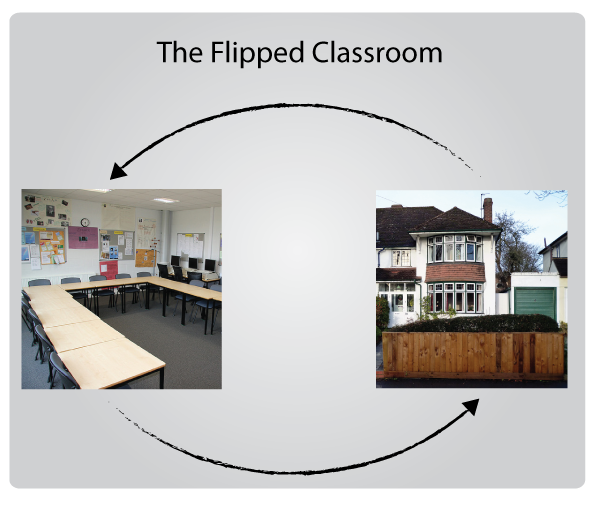Flipped classroom
The Flipped Classroom model is an increasingly popular method for encouraging Active Learning. The Flipped Classroom model requires a shift from an instructor centred approach to a learner centred approach, with a flexible approach allowing students to learn at their own pace and in their own time. This shift should create a more dynamic class environment that can be used to explore ideas and topics in greater depth.

‘Classroom’ by James F. Clay from Flickr (CC-BY-NC) and ‘My childhood home’ by Dave_S from Flick (CC-BY).
In 2011, Salman Khan the founder of the Khan Academy gave a Ted Talk on the possibility of video to revolutionise education. One of the points he focused on was the possibility for video to be used as part of a Flipped Classroom, with video content allowing students to engage with and digest teaching content in their own time before going to class or coming together with fellow learnings to take part in activities or discussion.
While much of the focus of the Flipped Classroom model is on the use of videos, this is not the only media that can be used to deliver content. Audio recordings, textbooks, or tutor created PDFs can also be effective methods to deliver the content. The most important part of the Flipped model is not the creation of content, it is the dynamic and active class sessions that it creates. Learners are able to engage with the subject to a greater extent if they have prepared for the class and engage in the activities.
The potential to use Flipped Learning in workplace training was highlighted by Jisc in 2014.
Definition of flipped learning:
“Flipped Learning is a pedagogical approach in which direct instruction moves from the group learning space to the individual learning space, and the resulting group space is transformed into a dynamic, interactive learning environment where the educator guides students as they apply concepts and engage creatively in the subject matter.”
Flipped Learning Network (FLN)
Information
Developed by the Educational Development Unit, University of the Highlands and Islands.
Disclaimer
UHI provides links to external sources of information and may refer to specific Web sites, products, processes or services within this resource. Such references are examples and are not endorsements and whilst every effort is taken to ensure the accuracy of information provided UHI is not responsible for any of the content or guidance. You are advised to exercise caution.
Information on social media websites may also be provided. Staff using social media websites must comply with the University’s social media policy. It is recommended that you fully understand the terms and conditions of use before using these sites and that you take steps to protect personal or sensitive data.
×Glossary
Accessibility
A characteristic of technology that enables people with disabilities to use it. For example, accessible Websites can be navigated by people with visual, hearing, motor, or cognitive impairments. Accessible design also benefits people with older or slower software and hardware.
Accredited
Official recognition awarded by an authority or body to recognise that certain standards have been achieved/met.
Active learning
A learner-centred model of learning that utilises activities in class sessions to enhance learning.
Andragogy
The theory and practice of teaching adult learners - see pedagogy.
Assessment
The process used to judge, evaluate or appraise whether a system or a person meets a set of criteria or requirements.
Asynchronous Learning.
Learning that uses methods or technology that enables the exchange of information outwith the boundaries of time and space. Used when working across time zones or where people are unlikely to all be available at the same time. Discussion boards and email are examples of tools that can be utilised.
Attribution
Information provided alongside a piece of work to identify the original creator or copyright owner.
Audience
The group of people that the learning has been designed to teach.
Audio lecture
A recording of either a live lecture or a scripted lecture that is then distributed online for learners to listen to.
Authoring Tool
Software tools used by developers and instructional designers to create e-learning materials.
Avatar
A graphic or icon used to represent a person in an online environment. Intended to enable users to add a personal touch to their online presence.
